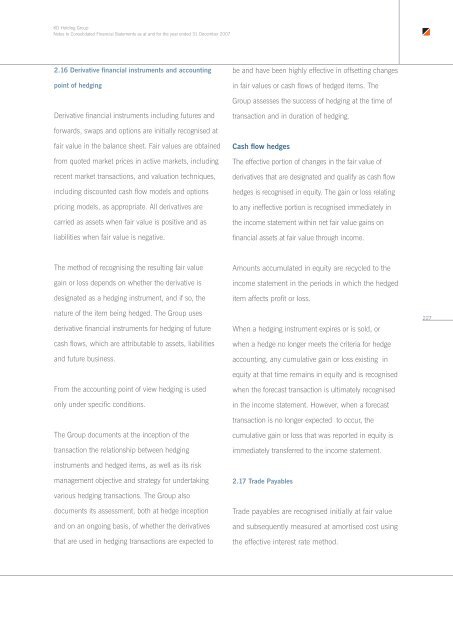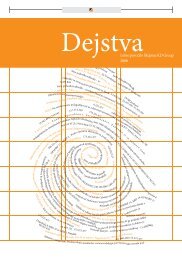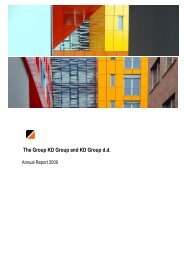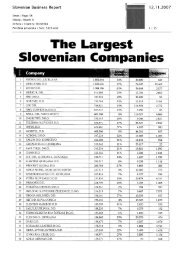We build business networks and relationships ... - skupina kd group
We build business networks and relationships ... - skupina kd group
We build business networks and relationships ... - skupina kd group
You also want an ePaper? Increase the reach of your titles
YUMPU automatically turns print PDFs into web optimized ePapers that Google loves.
KD Holding Group<br />
Notes to Consolidated Financial Statements as at <strong>and</strong> for the year ended 31 December 2007<br />
2.16 Derivative financial instruments <strong>and</strong> accounting<br />
point of hedging<br />
be <strong>and</strong> have been highly effective in offsetting changes<br />
in fair values or cash flows of hedged items. The<br />
Group assesses the success of hedging at the time of<br />
Derivative financial instruments including futures <strong>and</strong><br />
forwards, swaps <strong>and</strong> options are initially recognised at<br />
fair value in the balance sheet. Fair values are obtained<br />
from quoted market prices in active markets, including<br />
recent market transactions, <strong>and</strong> valuation techniques,<br />
including discounted cash flow models <strong>and</strong> options<br />
pricing models, as appropriate. All derivatives are<br />
carried as assets when fair value is positive <strong>and</strong> as<br />
liabilities when fair value is negative.<br />
transaction <strong>and</strong> in duration of hedging.<br />
Cash flow hedges<br />
The effective portion of changes in the fair value of<br />
derivatives that are designated <strong>and</strong> qualify as cash flow<br />
hedges is recognised in equity. The gain or loss relating<br />
to any ineffective portion is recognised immediately in<br />
the income statement within net fair value gains on<br />
financial assets at fair value through income.<br />
The method of recognising the resulting fair value<br />
gain or loss depends on whether the derivative is<br />
designated as a hedging instrument, <strong>and</strong> if so, the<br />
nature of the item being hedged. The Group uses<br />
derivative financial instruments for hedging of future<br />
cash flows, which are attributable to assets, liabilities<br />
<strong>and</strong> future <strong>business</strong>.<br />
From the accounting point of view hedging is used<br />
only under specific conditions.<br />
The Group documents at the inception of the<br />
transaction the relationship between hedging<br />
instruments <strong>and</strong> hedged items, as well as its risk<br />
management objective <strong>and</strong> strategy for undertaking<br />
various hedging transactions. The Group also<br />
documents its assessment, both at hedge inception<br />
<strong>and</strong> on an ongoing basis, of whether the derivatives<br />
that are used in hedging transactions are expected to<br />
Amounts accumulated in equity are recycled to the<br />
income statement in the periods in which the hedged<br />
item affects profit or loss.<br />
When a hedging instrument expires or is sold, or<br />
when a hedge no longer meets the criteria for hedge<br />
accounting, any cumulative gain or loss existing in<br />
equity at that time remains in equity <strong>and</strong> is recognised<br />
when the forecast transaction is ultimately recognised<br />
in the income statement. However, when a forecast<br />
transaction is no longer expected to occur, the<br />
cumulative gain or loss that was reported in equity is<br />
immediately transferred to the income statement.<br />
2.17 Trade Payables<br />
Trade payables are recognised initially at fair value<br />
<strong>and</strong> subsequently measured at amortised cost using<br />
the effective interest rate method.<br />
227







